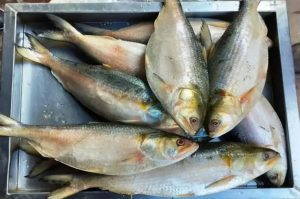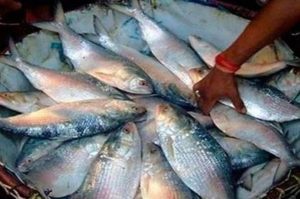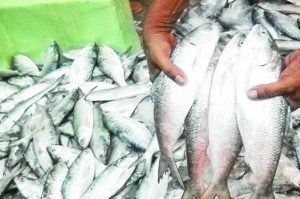Bangladesh Hilsa Export: The hilsa, often referred to as the “queen of fishes”, has long been a cultural and culinary symbol that transcends borders between Bangladesh and West Bengal. Every year, as Durga Puja approaches, Bengali households in Kolkata and beyond eagerly await the arrival of hilsa from across the Padma and Meghna rivers. This year too, the Bangladesh government granted permission to export 1,200 tonnes of hilsa to India as a goodwill gesture ahead of the festival.

Yet, despite the official nod, doubts loom large over whether such quantities will actually arrive in West Bengal’s markets. Reports from Bangladesh indicate an alarmingly low catch of hilsa in prime fishing belts such as Chandpur, Barishal, Bhola, Cox’s Bazar, Padma, and Jamuna, leaving exporters reluctant to commit.
Poor Catch Dampens Festive Expectations
According to members of the Bangladesh Fishermen Association, river conditions this season have not been favorable. Fish sizes are also much smaller than usual. While hilsa weighing 800–900 grams are available, the premium 1-kg-plus fish—the pride of Puja feasts—are scarce. Prices have shot up locally, with large hilsa selling for ₹2,300–2,400 even before export discussions began.
Exporters such as Mohammad Nasib, who usually take multiple licenses for the Indian trade, remain hesitant. “I have only taken one license this year, and I’m still undecided whether to proceed. The landings are weak, and unless the situation improves in the coming days, it may not be feasible,” he admitted.
Export Approvals vs. Actual Deliveries
History shows that approvals granted by Bangladesh rarely translate into full-scale exports. Over the last four years, of the 13,870 tonnes cleared for India, only 3,664 tonnes actually reached markets across the border.
The gap between permission and reality is attributed to several factors:
- Short-term scarcity during fishing bans.
- Local demand pressure in Bangladesh itself.
- High domestic prices discouraging exporters.
- Logistical bottlenecks at key land ports like Benapole-Petrapole.


Thus, although the Indian government and fish traders in Kolkata welcome the announcement, most remain cautious.
Impact on West Bengal’s Markets
The Howrah Wholesale Fish Market, one of India’s largest hubs for hilsa trade, is watching the developments closely. Syed Anwer Maqsood, secretary of the Fish Importers’ Association, voiced concern:
“Every year, we prepare our stock ahead of Puja because consumer demand peaks. But with the season starting early this year, and with reports of poor catches in Bangladesh, it is hard to predict how much fish will actually reach Kolkata markets. There is always a mismatch between approval and real delivery.”
Traders fear that if exports remain below expectation, hilsa prices in Kolkata could soar beyond affordability for middle-class households, with premium sizes easily crossing ₹2,500–₹3,000 per kilo.
The Symbolism of Hilsa Diplomacy
The export of hilsa is not just a matter of economics but also one of diplomacy. Over the years, Bangladesh has restricted hilsa exports, citing the need to conserve fish stocks. However, as a gesture of goodwill, the Dhaka government often makes an exception during Durga Puja, strengthening cultural ties with West Bengal.
This practice has been popularly dubbed “hilsa diplomacy”, where the iconic fish becomes a token of shared heritage and cross-border friendship. Yet, this year’s low catch raises questions about whether Bangladesh can maintain this tradition without hurting its own domestic supply.
Fishermen Struggling in Bangladesh
On the ground, fishermen across Bangladesh’s rivers are expressing frustration. The changing climate, reduced water flow due to upstream river management, and rampant pollution are all contributing to dwindling hilsa stocks.


According to environmental studies, hilsa migration has been disrupted due to altered river ecosystems, leading to lower breeding success. Local fishermen, dependent on daily catches for survival, face dwindling incomes. Many fear that if the trend continues, both domestic markets and exports could collapse in the coming years.
Alternatives Emerging in India
With uncertainty looming, Indian markets are increasingly looking towards alternative sources. Hilsa from Gujarat’s Bharuch region, although smaller in size, has been making its way into Bengal markets. Additionally, river fish from Odisha and Andhra Pradesh are being pushed as substitutes, though they cannot match the prestige of Padma hilsa.
For Bengalis, however, no substitute truly satisfies. The Padma hilsa’s distinct taste and oiliness are unmatched, making it the centerpiece of traditional Puja feasts like ilish bhapa, ilish paturi, and sorshe ilish.
Bangladesh Hilsa Export: Looking Ahead
The final word on exports will depend on how many traders in Bangladesh actually apply for licenses by the deadline of September 11. Even then, the number of consignments reaching Kolkata’s markets will be dictated by actual landings in Bangladeshi rivers over the next few weeks.
If the supply falls short, it will be another reminder of the fragile balance between tradition, diplomacy, and sustainability. Both countries may need to look at long-term conservation policies to ensure the survival of the hilsa, which is not only a delicacy but also a cultural bridge between two peoples.
External References for Deeper Reading
- Hilsa Diplomacy and Cultural Ties
- Bangladesh Fisheries Research Institute – Hilsa Studies
- West Bengal Fish Importers’ Association Updates
- Conservation Challenges of Hilsa
Also read: Home | Channel 6 Network – Latest News, Breaking Updates: Politics, Business, Tech & More

